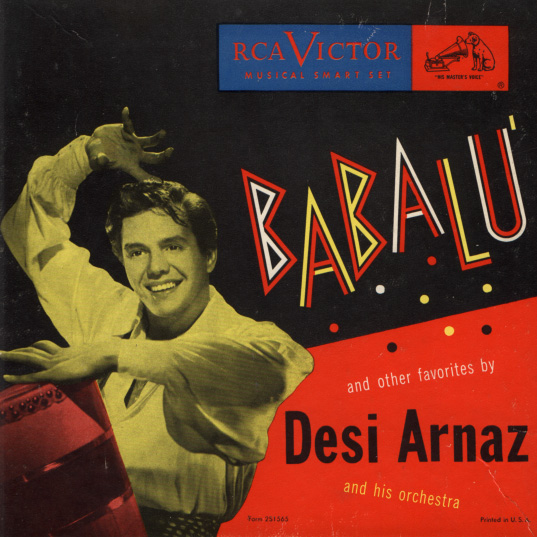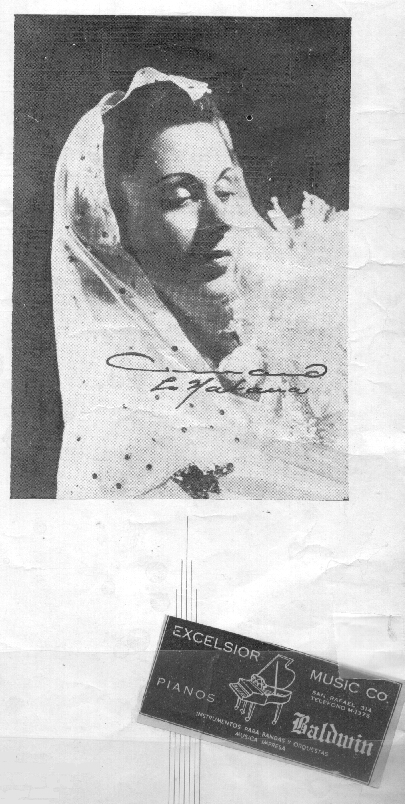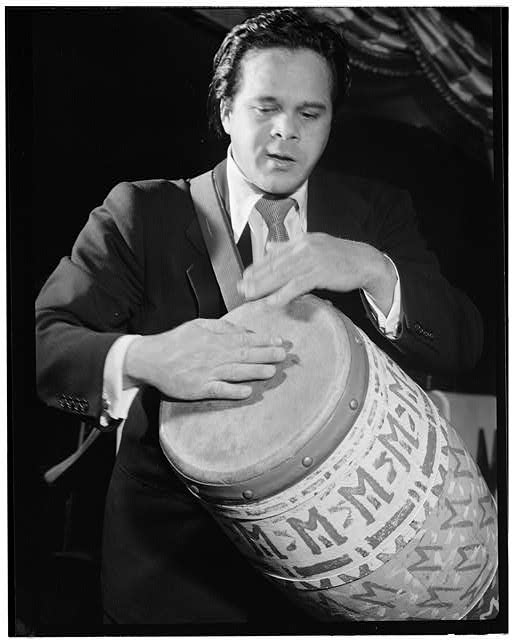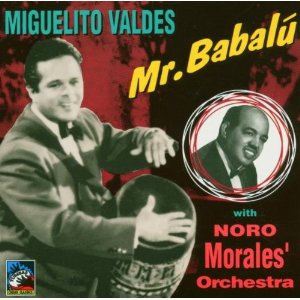Babalu a ye! The Origins Of ‘Babalu’
A tribute to a Santeria deity captured mainstream America’s heart when it became Ricky Ricardo’s theme song. And then there’s the matter of Miguelito Valdés, ‘Mr. Babalu’ pre-Desi.
By David McGee
Latin music purists scoff at Desi Arnaz’s version of “Babalu,” claiming Arnaz copped the arrangement and style of his 1946 recording from the real “Mr. Babalu,” Miguelito Valdés, who is still regarded as Cuban music’s greatest singer. Purists aside, though, Desi’s original “Babalu” recording is admirably incendiary, as is his wild performance of the song in his 1946 short film, Desi Arnaz and His Orchestra. Decry Desi’s “Babalu” at your peril. How many other actor-musicians with entrée to the great American mainstream in the 1950s regularly aligned himself with a sacred figure in Latin and West African culture, the “Father, lord of the Earth,” as Babalú-Ayé, the praise name of the spirit of the Earth, is known in those cultures? Desi did much more than simply make the song famous.
Desi Arnaz, 'Babalu' as performed with his orchestra in the 1946 short film Desi Arnaz and His Orchestra. This 'Babalu' is a rawer version that the one Desi would make famous on I Love Lucy (although there is one version in a Lucy episode that rivals this one for intensity and indeed is staged in a similar manner) and shows off the charismatic stage presence that made him a club sensation in New York in the late '40s, when he was one of the reigning mambo kings in the country after introducing the conga line to American audiences. This short film also features Desi and orchestra performing 'Guadalajara'--another I Love Lucy favorite--'Easy Street,' 'Tabu,' 'Pin Marin' and 'Say Si Si.' Like 'Babalu,' 'Tabu' is credited to songwriter Margarita Lecuona.At the Babalu Blog, Babalú-Ayé is described as “the Orisha name for St. Lazarus, who is commonly referred to as the father of the world. Though originally associated with smallpox, many of today's worshippers appeal to Babalú-Ayé for healing from HIV/AIDs. His colors are brown, black, and purple. His number is 17. His symbols are two dogs and crutches. He is portrayed dressed in burlap. He is offered white wine, popcorn, sesame seed candy, and a variety of grains, beans, and seeds. Many Cubans hold a vigil starting the night of December 16th. They get together and light candles and make offerings to Babalú-Ayé and wait for him to arrive at midnight. Come midnight they ask for San Lazaro to watch over them and keep them and their families safe and healthy.” Wikipedia offers a far more complex and thorough explanation of Babalú-Ayé but the contours of it conform to the facts noted above.
Margarita Lecuona composed ‘Babalu’ in 1941“Babalu” was written in 1941 by Margarita Lecuona (1910-1981), the niece of Ernesto Lecuona (1895-1963) and his sister Ernestine, who was Ernesto’s piano teacher. Ernesto was a world-renowned composer and world-class pianist who wrote some 600 songs and music for stage and film in both popular and classical styles. In 1942, his song “Always In My Heart (Siempre en mi Corazon)” was nominated for an Oscar for Best Song, but lost to Irving Berlin’s “White Christmas.”
No record exists of Ms. Lecuona explaining the inspiration for her “Babalu,” leading to a division among music scholars, with some believing the song is directly about the Santeria deity Babalú-Ayé, with others insisting it refers to Babalawo, a Santeria priest and diviner. Odds favor the Babalú-Ayé interpretation: in the lyrics the singer wonders aloud what to do with a statue of Babalú Ayé, now that a Santería rite had been invoked by others. He suggests lighting seventeen candles in the shape of a cross, then requests a cigar and aguardiente (a beverage known as “fiery water” for its high alcohol content of up to 60 percent by volume) in order to pay homage to the deity. The song winds down with the singer wishing for good luck, for love from his beloved woman, and for safe passage for he and his mate.
“Babalu”--Spanish Lyrics
1st VERSE
Babalu
Babalu
Babalu aye
Babalu aye
Babalu
Ta empezando lo velorio
Que le hacemo a Babalu
Dame diez y siete velas
Pa ponerle en cruz.
Dame un cabo de tabaco mayenye
Y un jarrito de aguardiente,
Dame un poco de dinero mayenye
Pa' que me de la suerte.
YoCHORUS
Quiere pedi
Que mi negra me quiera
Que tenga dinero
Y que no se muera
Av! Vo le quiero pedi a Babalu 'na negra muy santa como tu que no tenga otro negro
Pa' que no se fuera.2nd VERSE (CONCLUSION)
[Repeated 10 times:]Babalu a ye!
“Babalu”--English Lyrics
1st VERSE
Babalu
Babalu
Babalu aye
Babalu aye
Babalu
Jungle drums were madly beating,
In the glare of eerie lights;
While the natives kept repeating
Ancient jungle rites.
All at once the dusky warriors began to
Raise their arms to skies above
And a native then stepped forward to chant to his Voodoo Godess of love.
Ah!CHORUS
Great Babalu!
I'm so lost and forsaken.
Ah, great Babalu!
Bring back the love you've taken.
You can restore all the dreams that once were mine
If only you'll use some mystic sign.
Ah! Great Babalu!
Bring her back to me.
Ah!2nd VERSE (CONCLUSION)
[Repeated 10 times:]Babalu a ye!
***
The Original ‘Mr. Babalu’--And Still The Greatest?
“Babalu”’s most famous interpreter, pre-Desi, was the internationally famous Cuban sonero and composer Miguelito Valdés (1919-1978) whose repertoire of Afro-Cuban songs both celebrated the heritage of Cuban blacks and highlighted their suffering. He acquired the nickname "Mr Babalú" because he recorded and performed Margarita Lecuona’s song so often. From the age of 10 he grew-up in Havana’s Cayo Hueso district listening to Santería (Afro-Cuban cult music) and classical music. He befriended Arsenio Rodríguez, Chano Pozo and Félix Chappottín. He started boxing in 1926 for the Cuban YMCA and became Cuba’s amateur welterweight champion in 1929 and sang songs during radio interviews. He switched to music full-time as a singer with Sexteto Habanero Juvenil. After two years guitar and singing tuition from singer, guitarist and composer María Teresa Vera (1895-1965), he joined her group Sexteto Occidente in 1929 as a chorus singer. He relocated to Panama in 1933 and became a major star there as the vocalist with Lucho Azcarraga orchestra.
‘Babalu,’ by Miguelito Valdes, ‘Mr. Babalu’Shortly after returning to Cuba in September 1936, alto saxist and leader Manolo Castro recruited him to his high society band Los Hermanos Castro (founded in 1930; dissolved in 1960). Valdés’ innovative improvisational rendition of Afro-Cuban numbers caused a sensation. Finding the regime in Castro’s band too stingy and inflexible, he and six other members departed in 1937 to found a corporation that organised an 11-piece band including pianist, arranger and composer Anselmo Sacasas (1912-1998). The band acquired the name Orquesta Casino de la Playa when Valdés negotiated a five-year contract with the Summer Casino in Marianao Beach, then a daily slot on the CMQ radio station that launched them in Cuba and led to tours of Latin America. Casino de la Playa signed with RCA Victor in 1937 and made about 200 78s for the label, a number of which are collected on the Tumbao CDs Memories Of Cuba 1937-44 (1991, including Valdés’ original 1939 big hit recording of "Babalú" by Margarita Lecuona), Adios Africa 1937-40 (1994) and Fufuñando 1937-1940 (1995).
Valdés (as well as Sacasas) decided to leave Casino de la Playa and relocate to New York City. Accounts differ about his departure from Cuba. Shortly before leaving Cuba, Valdés provided lead vocals to a series of sides made in 1940 by Orquesta Havana-Riverside (a rival of Casino de la Playa founded in 1938). In addition, he recorded with Sexteto Nacional (personally reconvening the disbanded members) and the group of pianist/composer Enrique Bryon.
Valdés and Sacasas left Cuba in April 1940 and arrived in NYC on 16 May. Sacasas organised his own orchestra, which debuted at Chicago’s Colony Club in September 1940 including 17-year-old Tito Puente. Meanwhile, Xavier Cugat quickly sought-out Valdés and signed him to a five-year contract. He made his RCA Victor debut with Cugat in May 1940. Cugat recordings featuring Valdés are collected on Xavier Cugat And His Orchestra 1940-42 ‘91 (including his second recording of "Babalú" for Columbia in 1941) and Rumba Rumbero ‘92 on Tumbao. During his stint with Cugat, he sang at NYC’s Waldorf Astoria Hotel and other prestigious venues and performed in the 1942 Hollywood movie You Were Never Lovelier, starring Fred Astaire and Rita Heyworth.
Miguelita Valdes and His Orchestra, ‘Celina’Hot selling Cugat recordings enabled his photo to appear on the front cover of Billboard in April 1942, giving him national exposure. In 1942 Cugat released Valdés from his contract after the singer refused to work without a pay rise. He began a solo career as top-billing act at NYC’s La Conga club and later preformed at all the City’s prominent supper clubs. He recorded two albums on Decca with Machito and his Afro-Cubans in 1942 in 48 hours to beat a national musicians strike; tracks are collected on Cuban Rhythms (Tumbao, 1992). He relocated to Mexico City in 1942 where he appeared in 12 movies, giving him even greater exposure. He returned to the U.S. in September 1944 to reside in Los Angeles. Popular ’40s recordings with La Sonora Matancera and Noro Morales are collected on Señor Babalú on Tropical. He cut six sides in the mid-’40s with the Machito band on Verne, which are compiled on Guampampiro (Tumbao, 1997). He appeared in the movies Panamericana (1945) and with Machito band in Machito and Orchestra (1946) the first Columbia Pictures short in Sepia Tone, featuring Betty Reilly singing “Tierra Va Tamble.”
Debuting with his own big band in 1948, Valdés did a number of U.S. tours and prestigious residencies with them. In 1949 Valdés and orchestra cut 22 classic sidess during five sessions for Gabriel Oller’s SMC label with pianists René Hernández, Eddie Cano and Al Escobar, and percussionist Ray "Little Ray" Romero (1923-2006). This material is compiled on Mambo Dance Session (Caribe, 1994) and an overlapping 13 tracks are collected on Algo Nuevo (Tumbao, 2000). Mr. Babalú (Tumbao, 1993) compiles eight sides made with his own orchestra in 1949 and eight with the Noro Morales orchestra from 1951, including a version of "Babalú" with each band. He also recorded for Monogram (1950), Tico (1953) and as a soloist with the orchestra of pianist/composer René Touzet (1916-2003). Financial difficulties forced Valdés to disband his orchestra in 1954, but he retained Puerto Rican pianist Luisito Benjamín as an accompanist for tours. Facing the mid-’50s onslaught of rock ‘n’ roll and the emergence of new Latin stars, Valdés went into retirement in L.A.
Miguelita Valdes, ’Bruca Maniguà’Musical director Mario Bauzá invited him to return to New York to reunite with the Machito orchestra on the 1963 LP Reunion on Tico, which he regarded as one of his best recordings. This re-established his career, leading to his own TV show (1966-76, with backing from Lucy and Desi) and recording dates, including Mejico Yo Te Canto/I Sing Of Mexico (Tico, 1964), ‘Canciones Mi Mama No Me Enseño/Spanish Songs Mama Never Taught Me (1964) and Mas Canciones Mi Mama No Me Enseño/More Spanish Songs Mama Never Taught Me (1965), both on Tico with Tito Puente, Machito, Graciela and Joe Cuba; Chico O’Farrill’s Married Well (Verve, 1967), providing lead vocals to "Manteca"; Inolvidables (Verve, 1967) arranged and conducted by O’Farrill; Miguelito Canta A Panama (Mericana, 1977) made in Panama; and Mister Babalú en Perú on IEMPSA (issued on LAD ‘80). He had a mild heart attack in Mexico in March 1978 and collapsed and died on stage during a performance at the Hotel Tequendama, Bogotá, Colombia, in November 1978.
(Some biographical details provided by John Child at el watusi)
The Miguelito Valdes collection Mr. Babalu 1949-1950 is available at www.amazon.com
Founder/Publisher/Editor: David McGee
Contributing Editors: Billy Altman, Laura Fissinger, Christopher Hill, Derk Richardson
Logo Design: John Mendelsohn (www.johnmendelsohn.com)
Website Design: Kieran McGee (www.kieranmcgee.com)
Staff Photographers: Audrey Harrod (Louisville, KY; www.flickr.com/audreyharrod), Alicia Zappier (New York)
E-mail: thebluegrassspecial@gmail.com
Mailing Address: David McGee, 201 W. 85 St.—5B, New York, NY 10024






